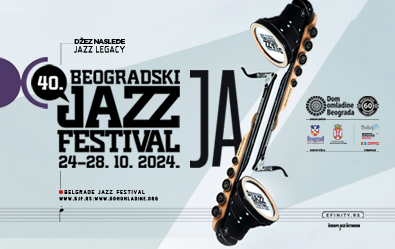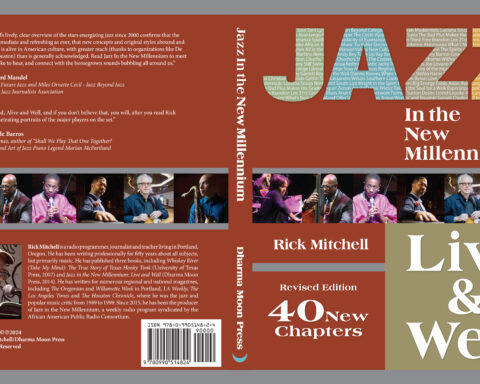The ghost of George Wein dropped by and mingled with jazzmen of Belgrade the last weekend of October (as usual). The occasion was the Belgrade Jazz Festival, in Serbia, southeastern Europe.
A member of the Europe Jazz Network, the BJF had celebrated its 40th edition, 20th since its post-civil war renewal and tenth Serbian Showcase.
As written in “Belgrade Jazz Festival 1971-2020” by Vojislav Voja Pantic, the BJF’s artistic director, jazz journalist, promoter, educator and mathematician, the seed of jazz was planted back in 1958 by producer George Wein and U.S. State Department. The test of the music before a large audience began on November 6, 1970, at “the greatest jazz concert in Belgrade ever,” by the Anita O’Day Trio, Charles Mingus Quintet and Earl Hines Quartet featuring Marva Josie. In 1971 the first official edition of the festival took place in Trade Union Congress Hall as an affiliate of the Newport Jazz Festival. In 1974 it was renamed the Belgrade Jazz Festival, and gained autonomy through the programming of impresario Aleksandar Zivkovic.
Over four decades the Belgrade Festival has had very fertile and very dry years — including entire suspension from 1990 until 2005 due to civil war in the Balkans. The Fest’s concept has followed currents of jazz development in the world but it has always dared to push the boundaries in promoting some acts at the time considered novelties. As the late saxophone, clarinet player and member of a BJF board Milivoje Mica Markovic once advised, rather than listing all who had played (famous names in jazz history) it was important to mention when they had played. American journalist Thomas Conrad, a frequent guest at the fest, at last year’s opening emphasized having heard several prominent contemporary musicians, here, in Belgrade, for the first time. The fest has spread jazz seeds across the broad region by featuring stars as well as musicians who, shortly after having performing here received world wide recognition.
BJF is held at, produced and organized by Belgrade Youth Center, in the historic heart of the city. It promotes American and European music, strongly supported by foreign cultural exchange funds, and Serbian music, supported by public media, state and city funds and artist’s association, to cultivate local audience and young musicians.
Belgrade may be hard to love but at heart (especially during Indian summer) it is a city charming for its anachronisms and antagonisms: present and past, East and West. It is hospitable, and offers, at fair prices, festival tickets (less than $50 for a five-day pass); difficult to pronounce (even prior to tasting) strong spirits and cuisine (a mixture of oriental and central European): abundant lick-your-fingers-tasty cholesterol-bombs (which help you survive festival’s five-day, two double programs-in-a-row-that-end in-the-wee-hours tempo which makes you return, even more probably then throwing coins in a fountain. Good news is that the most of the concerts are in one, building so you can burn off your dinner calories going up and down the stairs. Bad news is that you have to eat prior, after, or prior and after the program because there are no overlaps and the breaks are long (or short) enough for a chat, drink or a cigarette.
This year, the concept of daring new proposals was set aside in favor of greeting old friends, artists that had created the spirit of BJF. Artistic director Pantic emphasized two main themes: premiers of today’s most important jazz musicians and recall of the international and local giants that have marked the brightest days of its history. The 16 concerts were a real treat: Cecile McLorin Salvant with Sullivan Fortner, Yasushi Nakamura, and Kyle Pool; Kris Davis with Val Jeanty, Nick Dunston and Terri Lyne Carrington; Jason Moran performing solo; Bill Frisell with Gerald Clayton, Greg Tardy and Johnathan Blake; Anat Cohen’s Quartetinho with Vitor Goncalves, Tai Mashiach and James Shipp; Rudresh Mahanthappa; Rodrigo Amado, Goncalo Almeida and Onno Govaert; Emile Parisien; Theo Ceccaldi and Jim Hart; Gianluca Petrella . . . The lineup was like last year’s JJA best-of lists and some of European lists, too. Here are some highlights:
“Love”, almost whispered by Cecile McLorin Salvant into the foggily silent concert hall audience of some thousand people, marked the official opening of BJF. Her set list, drawn from various albums, brought to the festival cabaret dramatics, emotionally tense vocalise treatments in French and Portuguese, a chat with pianist Fortner and drummer Kyle Pool, a song by another BJF friend, Dianne Reeves, and a dedication to Anat Cohen. Bassist Nakamura wholeheartedly sustained Salvant’s timbre and Fortner’s bass lines. A delicately extended ten minute version of “Wuthering Hights” (from Ghost Song, 2022) resonated from her a capella (re)call of Kate Bush’s song, demonstrating her unique phrasing and evoking every possible emotion accompanying love from despair to desire.
Last year at the North Sea Jazz festival in Rotterdam harpist Brandee Younger, presenting Alis Coltrane’s pieces), joked, “Who needs piano when there is a harp?” Jason Moran must have heard her, and created Ellingtonia in response. It’s his manifesto regarding the piano as an instrument, the Duke’s piano as a complete orchestra, and swing as a jazz feature.
His solo exploration of stride-to-modern piano styles burst with allusions, including a three-minutes-long drive down the keyboard encompassing thundering play in the lowest register and the clearest highest notes. He treated us with a deconstruction of the melody, harmony, rhythm and arrangements of “Ellingtonian language” in diverse tempi, touching on “Black and Tan Fantasy”, “I Got It Bad”, “Reflections in D”, “Melancholia”, “It Don’t Mean a Thing”, “Lotus Blossom”, and an audience-supported snapping rag, “Dancers in Love”.
Anat Cohen is a longtime supporter of BJF. Her clarinets carry that catchy, close-to-Balkans’ sensibility hypnotic sound, flexibie phrasing and the secret of the Levant being the cradle of the world. Her ensemble Quartetinho proved it by uniting strains of Egberto Gismonti’s Brazil, Thelonious Monk’s uniqueness and the tender dreamscapes of Czech Antonin Dvorak,
arranged for bass clarinet, accordion, vibraphone and double bass in her original compositions “Valsa do Sul” and “The Night Owl”, Spanishly” and vivid “Paco” by Tal Mashiach, and seductive “Tango para Guillermo” by Vitor Goncalves from their freshly released album Bloom (Anzic Records).
Alto saxophonist Mahanthappa’s Hero Trio, with Phil Donkin – double bass and Tim Angulo on drums — gave a pop-like touch of celebration, presenting music by artists who had inspired him.
Americana is BJF’s small, upstairs venue (capacity approximately 200 seated, 600 standing), a cosy little black box for late night concerts. It preserves the memory of famed jazzmen such as Chet Baker, shortly before his death, jamming with locals till wee hours in a club-like atmosphere. Usually it is reserved for intimate or daring programs such as avant-garde or Saturday night concerts for young audiences. Its stage is only a few feet from attendees, amplifying musical impressions.
It hosted tenor saxophonist Rodrigo Amado‘s Portuguese/Dutch trio The Attic with Goncalo Almeida (double bass), and Onno Govaert (drums). Amado, acknowledged improviser, is known as an important initiator of the praised Portuguese free jazz and improvised music label Clean Feed Records. He wove his large scale, dynamic melodies in mostly mid and fast tempos. Almeida’s bass, so low it was almost indistinguishable, supported him and conversed with Govaert’s provocations on his small drum kit. Their hour-long performance comprised two improvisations, with expressive solos, ended it in total unison, presenting perfect trio unity.
Soprano saxophonist Emile Parisien‘s 20-years-old quartet promoted their new album Let Them Cook (ACT) as an enthusiastically French “a la carte, sweets, wine and cheese” menu of original compositions by the members of the band. Parisien’s rich timbres and phrasing amplified by electronic effects, with Julien Touery’s playfully piano phrasing seasoned by drummer Julien Loutellier in collaboration with bassist Ivan Gelugne, resulted in inspired cooking.
The artists with pianist Kris Davis playing their album Diatom Ribbons, and guitarist Bill Frisell‘s Four – a long-awaited newcomer to the fest who served as this year’s capstone — gave Belgrade the finest overseas contemporary sensibility.
The Serbian Showcase consisted of six concerts for press only, and a great public Serbian All-Stars concert featuring Luka Ignjatovic (alto saxophonist, composer, educator, band leader and promoter of young musicians), Dragan Calina (piano), Milan Nikolic (bass), Aleksandar Cvetkovic (drums), flutist Milena Jancuric and saxophonist Rastko Obradovic, among others. Their playlist comprised works by mid 20th-century Serbian/Yugoslav composers including the late Dusko Gojkovic, Bora Rokovic, Lala Kovacev who explored traditional music within jazz idiom, honoring them as giants of early Belgrade Jazz Festivals, in accord with the fest slogan “The Jazz Legacy“.

The RTS Big Band, at the Festival start, recalled the BJF’s first international guests: Duke and Miles among them. It would be nice to hear again the modern arrangements performed by young (average age: 30), creative and highly educated members of the ensemble, considering that Belgrade’s big band — among the best in Europe during 1950s, ’60s, ’80s.
The audience at this year’s edition was slightly different than in the past, attaining about 80% of the festival’s capacity. The steady core audience had shrunk, but a newly interested group of young students explored the festival. Sponsorship seems to have influenced the number of attendees, as “free“ tickets played an important part in bringing in new listeners to more popular performances.
The BJF’s Youth Centre team was praised by the performers for the fest’s level of organization. Belgrade — without a steady jazz club or a branded jazz label, relying on the enthusiasm of the jazz community, the life-commitment of several people, and the Academy for Music and Grammar school — had offered jazzmen of this region important, up-to-date reference points for the ideas now traveling through jazz world. Congratulations, BJF. May you let loose your creative and daring spirit, to continue making each edition a unique jazz feast.











